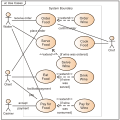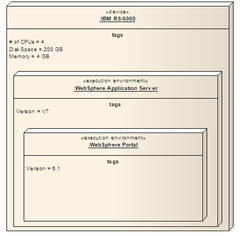- Node (UML)
-
A node In the Unified Modeling Language (UML) is a computational resource upon which UML artifacts may be deployed for execution. [1]
There are two types of nodes: device nodes and execution environments.
- A device represents hardware devices: a physical computational resource with processing capability upon which UML artifacts may be deployed for execution. Devices may be complex (i.e., they may consist of other devices).[1]
- An execution environment represents software containers (such as operating systems, JVM, servlet/EJB containers, application servers, portal servers etc.) This is a node that offers an execution environment for specific types of components that are deployed on it in the form of deployable artifacts.[1]
Execution environments can be nested. Nodes can be interconnected through communication paths to define network structures. A communication path is an "association between two DeploymentTargets, through which they are able to exchange signals and messages".[1]
Usage
When modeling devices, it is possible to model them in several different ways:
- Name a device using the type and make, for instance "IBM RS6000", "HP 9000".
- Name a device using its intended function, for instance "Database Server", "High Speed Switch"
- Name a device using the operating system deployed on it, for instance "Linux Server", "Solaris Server".
Use tagged values to specify characteristics of devices / execution environments, for instance "Memory=2GB", "Disk Space=32GB", "Version=2.5.1".
References
- ^ a b c d OMG (2008). OMG Unified Modeling Language (OMG UML), Superstructure, V2.1.2 p.199-210.
Unified Modeling Language Actors Organizations: Object Management Group • UML Partners Persons: Grady Booch • Ivar Jacobson • James Rumbaugh


Concepts Object oriented: Object-oriented programming • Object-oriented analysis and design
Structure: Actor • Attribute • Artifact • Class • Component • Interface • Object • Package • Profile diagram
Behavior: Activity • Event • Message • Method • State • Use case
Relationships: Aggregation • Association • Composition • Dependency • Generalization (or Inheritance)
Extensibility: Profile • Stereotype
Other concepts: MultiplicityDiagrams StructuralBehaviourActivity diagram • State Machine diagram • Use case diagramInteractionDerived languages Systems Modeling Language (SysML) • UML eXchange Format (UXF) • XML Metadata Interchange (XMI)Other topics Categories:- Unified Modeling Language
- Unified Modeling Language stubs
Wikimedia Foundation. 2010.

